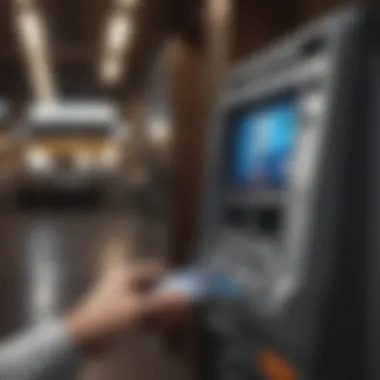Using Virtual Cards for ATM Withdrawals: Insights


Intro
In the modern financial landscape, using virtual cards has become increasingly common, especially for cash withdrawals at Automated Teller Machines (ATMs). The concept may seem straightforward, but misconceptions abound, leaving many users unsure about their practicality. It’s time to take a closer look into the nuances of how virtual cards function in conjunction with ATMs, how they’re regulated, and what the future holds for these digital instruments.
Virtual cards offer a bridge between convenience and security. Designed primarily for online transactions, their application in the ATM context introduces both potential and limitations. Understanding these aspects is essential not just for tech-savvy users, but also for anyone keen on maximizing their banking experience.
Key points to consider include:
- The technology behind virtual cards and their interplay with traditional banking.
- Addressing common myths that lead to confusion.
- Analyzing safety measures and regulations surrounding their use.
- Discussing emerging trends in digital banking.
This article will equip readers with the information required to navigate this evolving landscape smoothly, whether they are new to the idea or looking to refine their understanding.
Key Terms and Definitions
To grasp the subject fully, it is vital to define essential terms related to virtual cards and ATMs:
- Virtual Card: A digital substitute for a physical card, usually linked to a bank account or a financial service. Unlike traditional cards, they are typically used for online transactions but can be utilized for ATM cash withdrawals as well.
- ATM (Automated Teller Machine): A self-service machine allowing users to perform banking transactions such as cash withdrawals, deposits, and transfers without the need for a human teller.
- PIN (Personal Identification Number): A unique numeric code that adds a layer of security, enabling users to authenticate their identity during transactions.
Understanding these terms lays the groundwork for the following discussions.
Common Misconceptions
It’s easy to get loud about what virtual cards can or can’t do, but misconceptions can lead to misinformed decisions. Here are a few debunked myths:
- Myth 1: Virtual cards can’t be used at ATMs. This isn’t entirely true. While it’s more common to use them for online purchases, many services are expanding their use to physical transactions, including ATMs.
- Myth 2: Virtual cards are only secure when used online. Security features like encryption and multi-factor authentication apply equally at ATMs, adding layers of safety even for physical cash withdrawals.
- Myth 3: There are hefty fees for using virtual cards at ATMs. While some banks may charge fees, it’s not a universal rule. Knowing your bank’s specific policies can save you unnecessary costs.
"Understanding the myths about virtual cards can lead to more informed choices for users looking to enhance their banking experience."
Expert Advice
Navigating this new terrain requires insight from the experts, so here are strategies to consider:
- Research Your Bank’s Policies: Before heading to an ATM, ensure that your specific virtual card is supported. Not all cards or banks have the same capabilities.
- Use Reliable Providers: Seek out financial institutions with a strong reputation. Reliability in technology can translate to smoother transactions.
- Watch for Expiration and Replacements: Digital channels can glitch; keep aware of your card's status to avoid last-minute surprises when you need cash.
With clear knowledge and guidelines, users can step with confidence into the world of virtual card transactions at ATMs. The objective is not only to maximize functionality but also to ensure your bank experience is as seamless as possible.
Preamble to Virtual Cards
In today's digital world, virtual cards are becoming increasingly significant, especially with the growing reliance on online transactions and mobile banking. These cards are designed primarily for the digital landscape, allowing users to make purchases without the need for a physical card. This section sheds light on the core aspects surrounding virtual cards, highlighting their importance in facilitating digital payments while also addressing some of the concerns that come with them.
Definition and Purpose
A virtual card is essentially a digital version of a standard bank card, equipped with a unique card number, expiration date, and CVV code—just like any physical card. The key difference is that it exists only online, making it an attractive option for individuals wary of sharing their main card details during online transactions. The purpose of these cards extends beyond simple security; they offer various functionalities that cater to a modern, technology-driven lifestyle.
For instance, using a virtual card helps in managing spending. Users can load a specific amount onto the virtual card, ensuring they do not overspend while shopping online. Moreover, this system assists in mitigating fraud risks, as users can generate temporary or single-use card numbers for transactions. This can help keep the main card details shielded from potential hackers—a valid concern in this age of increasing cyber threats.
Types of Virtual Cards
There are several types of virtual cards available, each serving diverse needs and preferences:
- Single-use Virtual Cards: These are designed for one-time transactions, ensuring that even if the details are compromised, they cannot be used again. Ideal for secure online purchases, they offer peace of mind.
- Reloadable Virtual Cards: These can be loaded with funds multiple times, acting similarly to prepaid cards. They are handy for budgeting, allowing users to control their spending without the risk of running into debt.
- Corporate Virtual Cards: Tailored for businesses, these cards help manage employee expenses efficiently. Companies can issue different cards to employees with specific limits, simplifying the tracking of business costs.
- Virtual Debit Cards: Linking directly to a bank account, these cards provide users with a convenient way to access funds without needing a physical debit card. They can be used just like a regular bank card, online or at ATMs.
Understanding these types ensures that users make informed decisions based on their unique financial needs. With this knowledge in hand, one can appreciate how virtual cards serve not only as a payment method but also as a tool for better financial management.
Understanding ATMs
Automated Teller Machines, or ATMs as we commonly know them, have evolved beyond mere cash dispensers. They serve as a critical junction in the banking world, allowing individuals easy access to their funds, regardless of their physical location. Recognizing how ATMs function and the variety of services offered through these machines is essential when contemplating the use of virtual cards.
Understanding ATMs not only informs users about how best to utilize their bank cards, be they physical or virtual, but it also highlights the conveniences and limitations inherent in these machines. For instance, ATMs are instrumental in expanding a user’s banking capabilities, enabling more than just cash withdrawals. They also provide access to account balances, and let users transfer money or make payments directly. As such, it’s crucial for users to familiarize themselves with how these operations work, especially if they wish to use virtual cards in this context.
How ATMs Function
At their core, ATMs operate as sophisticated digital interfaces harmonizing with central bank systems to provide seamless access to accounts. When a card is inserted, the machine scans the card’s embedded chip and instantly connects to its issuing bank via a secure network. This connection permits users to perform transactions such as withdrawals, deposits, and inquiries without stepping foot inside a physical bank branch.
The interaction between the ATM and the user involves several conducted steps:
- Card Verification: The ATM verifies the card’s validity.
- Authentication: Users input their PIN, fostering secure access to their accounts.
- Transaction Process: Users select the type of transaction they want to perform, and the ATM communicates with the bank’s system to execute it.
"Understanding the functionality of ATMs can significantly ease the process, especially when using digital tools like virtual cards."


Having clarity on this mechanism is particularly important when using virtual cards which may not be as widely accepted at all ATMs compared to traditional cards.
Types of Withdrawals
While ATMs are primarily recognized for cash withdrawals, they provide a broader range of services that cater to various banking needs. Understanding these different types enhances user experience and satisfaction when interacting with ATMs. Each type of withdrawal fulfills distinct needs and has its own benefits.
Cash Withdrawals
Cash withdrawals are undoubtedly the most frequented service provided by ATMs. This allows users to access ready cash without delay, which can be crucial in times of emergency or when immediate purchases are required. The process is straightforward: the user selects the desired amount, and the ATM dispenses the cash through a secure channel.
One key characteristic of cash withdrawals is their ability to provide instant liquidity.
- Convenience: It serves as a quick solution, especially during weekends or holidays when banks may be closed.
- Accessibility: Various ATMs are placed in areas where traditional banking is not easily accessible, making it a popular choice for users in remote locations.
On the downside, cash withdrawals may incur transaction fees depending on bank policies and whether the ATM belongs to the same network as the issuing bank. Furthermore, using a virtual card might limit the amount a user can withdraw, as many institutions impose stricter regulations regarding digital transactions.
Balance Inquiries
Balance inquiries represent another crucial service offered by ATMs. They provide users with real-time visibility into their account statuses, which is especially beneficial for financial tracking and management. Users can monitor transactions and ensure that they have the necessary funds before making purchases or withdrawals, preventing overdraft fees and other financial complications.
The key appeal of balance inquiries lies in their immediacy and the control that it offers users.
- Informed Decisions: Users can make knowledgeable decisions based on accurate balance information, making it easier to budget daily expenditures.
- Convenient Banking: It sidesteps the need to visit a bank branch or use online banking platforms for simple queries.
However, one limitation is that it can lead to confusion if the user fails to account for pending transactions, resulting in potential overdrafts. By failing to track these thoroughly, users can unintentionally put themselves in a precarious financial situation.
Other Services
Beyond cash and balance-related transactions, ATMs can facilitate a variety of other banking services. This range includes money transfers, bill payments, and even mobile recharges in some regions. As banks innovate, the functionality of ATMs continues to expand, catering to evolving consumer needs.
This diverse array of services enhances the overall banking experience.
- Enhanced Accessibility: Users can perform a range of financial activities without needing to go into a bank, increasing efficiency.
- Time-Saving: Performing multiple transactions at once means less time spent waiting in lines or managing administrative tasks.
Nonetheless, the availability of such services does depend on the ATM’s configuration and the service agreements of the individual banks. Not every machine offers the same features, and that can lead to various frustrations.
In summary, comprehending how ATMs work and the nature of different withdrawal types enriches the conversation surrounding the usage of virtual cards. Understanding these features can help in making more informed choices when navigating cashless transactions.
Can Virtual Cards Be Used at ATMs?
The question of whether virtual cards can be used at ATMs is not just a passing curiosity—it's an important consideration for anyone leaning towards digital banking solutions. As the world becomes increasingly digital-first, understanding the interplay between virtual cards and ATMs is crucial. With virtual cards gaining ground as secure payment methods, the implications of their use at ATMs are manifold. They carry great potential for convenience, but also come with their share of hurdles.
Compatibility with ATM Systems
Virtual cards are inherently designed for online transactions, yet a growing number of ATMs are accommodating them. The compatibility hinges mainly on the card network they utilize. Many ATMs that accept traditional debit or credit cards are also equipped to handle virtual card transactions. However, it’s not as simple as it looks. While some ATMs support contactless payments, others primarily rely on traditional magnetic stripe or chip methods, limiting the options for virtual cards. It’s a stark reminder that not all ATMs are created equal.
Key Points in Compatibility:
- Virtual cards typically issue a card number, expiration date, and CVV, just like a physical card.
- Ensure the ATM supports the network of your virtual card (Visa, MasterCard, etc.).
- Contactless ATMs can speed up transaction times, but not all virtual cards support this feature.
Limitations and Restrictions
Despite the allure of virtual cards, certain limitations and restrictions surface, shaped by both bank policies and network capabilities. Policing the use of virtual cards is pivotal in maintaining security, but these checks can hold back users.
Bank Policies
The realm of bank policies introduces a tapestry of differing practices. Each bank has its own set of rules that dictate how virtual cards can be used at ATMs. For instance, some banks might outright prohibit cash withdrawals from virtual cards, enforcing a stricter oversight on funds and access. Meanwhile, others permit such actions but impose a limit on the withdrawal amount, which can become a significant hurdle when cash is necessary.
Key Characteristics of Bank Policies:
- Vary between institutions—research is key.
- Some banks support cash withdrawals; others don’t, or set limits.
- Can enhance security but may frustrate user experience.
The unique feature of regulatory policies often serves as a safeguard against unauthorized access. However, this can turn into an inconvenience, especially during times of need. That's why it's crucial for users to tap into their bank's guidelines before relying on virtual cards for cash transactions.
Network Limitations
Network limitations further complicate matters. Not all ATM networks are universally compatible with virtual cards, and this lessens the flexibility users expect from digital banking solutions.
Understanding Network Limitations:
- Not all ATMs belong to bank-owned networks; generic terminals might pose issues.
- Certain international networks may not accept US-issued virtual cards.


Like bank policies, network constraints can restrict access to funds and significantly impede cash withdrawals, particularly for travelers or those navigating uncharted banking waters.
In Summary: Both bank policies and network limitations play a crucial role in shaping the functionality of virtual cards at ATMs. Understanding these elements can pave the way for a smoother interaction, offering clarity and confidence on how to use these technological tools for financial navigations.
Step-by-Step Guide to Using Virtual Cards at ATMs
Using virtual cards for cash withdrawals at ATMs can seem like navigating a maze, but breaking it down into manageable steps simplifies the process. This guide aims to illustrate essential elements, advantages, and considerations surrounding the use of virtual cards, focusing on how to leverage this technology effectively.
Preliminary Requirements
Before you can consider withdrawing cash using a virtual card, a few prerequisites must be met. First and foremost, you must have a virtual card issued by your bank or a valid financial institution. These cards are generally linked directly to your primary bank account or a specific deposit account, making it essential to ensure your funds are adequately available to be accessed.
Key Aspects to Consider:
- Bank Policies: Different banks have various policies regarding virtual card issuance and usage. It's advisable to check for any limitations or requirements that they might have in place.
- ATM Compatibility: Not every ATM will recognize virtual cards, especially if they don’t support certain card networks. Carry out some research on local ATMs that are compatible with your virtual card.
- Internet Connection: While ATMs themselves don’t require an active internet connection to dispense cash, your virtual card might need internet connectivity during the activation or setup process.
Execution of Transactions
Once you've pinned down your preliminary setup, the execution of transactions comes next. This step can be broken down into two main subcategories: Accessing Funds and Transaction Fees.
Accessing Funds
When it comes to accessing funds, using a virtual card at ATMs can bring several surprises. A crucial factor here is that the access method might differ from using a traditional debit card. Typically, you'll need to enter specific card information directly into the ATM, which might feel a bit unorthodox at first.
This unique approach can be seen as beneficial because it enhances control and tracking over one’s financial resources, but it can also slow down the process.
Unique Feature of Accessing Funds: Many users appreciate that virtual cards often provide an extra layer of security, reducing the risk of theft compared to standard plastic cards.
However, keep in mind that processing sometimes may take longer, as the necessary verification of virtual card data must occur in real-time.
Transaction Fees
Transaction fees can be a daunting aspect for some when withdrawing from ATMs using virtual cards. Just like using conventional debit or credit cards, where fees often apply, virtual cards have their share of fees set by banks and ATM operators. The key characteristic here is that the fee structure may vary significantly.
Understanding Transaction Fees: Knowing the types and amounts of fees can help you plan ahead. Fees could be charged for access to certain ATM networks or when withdrawing funds in a foreign country.
In essence, while the ability to use a virtual card enhances accessibility, it's essential to account for these potential costs. In some instances, virtual cards may apply fewer fees than traditional card options, offering potential savings for intelligent users.
Overall, grasping the steps involved in using virtual cards at ATMs—whether through preliminary preparations or understanding access and fees—can significantly contribute to unlocking this multifaceted banking tool effectively. Each individual’s experience may vary, but being informed is half the battle.
Safety and Security Considerations
In today's financial environment, safety and security are non-negotiable, especially when it comes to utilizing virtual cards at ATMs. With the growing reliance on digital transactions, understanding the potential risks and implementing robust security measures is crucial for any user. Financial institutions and customers alike need to grasp the nuances of using virtual cards not just to enhance convenience, but to fortify their financial safety.
The use of virtual cards introduces a layer of complexity that demands attention. Users often assume that because these cards are digital, they inherently come with less risk; however, that's not necessarily the case. A clear understanding of the risks and the implementation of strategies to mitigate them can make a significant difference in securing one's financial information.
Risks Associated with Virtual Cards
One of the primary concerns with virtual cards is exposure to online fraud. Since these cards usually can be generated and used instantly, there is always the chance they may end up in the wrong hands. Cybercriminals are constantly on the lookout for vulnerabilities, so having a virtual card that can be compromised through phishing or other tactics can lead to unauthorized transactions.
Additionally, users must be aware of the risks originating from public ATMs.
- Skimming Devices: Malicious entities have become quite adept at installing skimming devices on ATMs, capturing essential card information. Even virtual cards, if not properly secured, can be targets.
- Insecure Connections: When accessing your bank account via public Wi-Fi to access a virtual card, you may unknowingly expose your sensitive information to snoopers. Overall, it’s vital to scrutinize where and how transactions are conducted.
Best Practices for Security
To navigate the digital waters of banking safely, adhering to best practices is paramount. These practices not only shield your virtual card but also create an overall safer financial experience.
Unique PIN Codes
Creating a unique PIN code for your virtual card can significantly bolster security. Unlike a commonly used number, a personalized PIN adds an extra level of defense against unauthorized access.
- Key Characteristic: The strength of a unique PIN lies in its unpredictability. A combination of numbers that isn't easily guessed or associated with your personal data makes it hard for anyone else to use your card.
- Benefits: Users who take the time to set a strong, unique code benefit from increased security, as most fraud attempts often rely on using easily obtainable information.
- Considerations: Be mindful not to share your PIN with anyone, and guard against common pitfalls such as using birthdays or simple sequences that a potential thief could guess.
Monitoring Transactions
Keeping track of transactions made with your virtual card serves as an effective line of defense. Regularly monitoring your account can help detect discrepancies quickly.
- Key Feature: Real-time alerts notify you instantly about any transactions, which can help stop fraud in its tracks before significant damage occurs.
- Advantages: Being proactive ensures you are the first to know of any suspicious activity, allowing for prompt reporting to your bank and mitigating potential losses.
- Accessible Features: Many financial institutions provide user-friendly mobile apps that allow for easy tracking of transactions, making it simpler than ever to stay on top of your financial activity.
"A little vigilance goes a long way in the digital banking world. Monitoring and unique security measures can save time and money in the long run."
By adopting these best practices, you not only ensure your virtual card is secure but also cultivate a more profound understanding of digital banking safety. In an ever-evolving landscape of financial technology, knowledge combined with action can serve as a solid shield against threats.


Comparative Analysis of Virtual Cards and Traditional Bank Cards
Understanding the differences between virtual cards and traditional bank cards is not just an academic exercise; it’s vital for consumers to make informed financial choices. The comparative analysis helps to highlight not only the advantages and disadvantages of each card type but also sheds light on their compatibility with the evolving landscape of digital banking.
Advantages of Virtual Cards
Virtual cards are becoming increasingly popular among users who value convenience and security. To better grasp their benefits, consider the following aspects:
- Enhanced Security: Virtual cards typically provide a one-time-use card number, reducing the risk of fraud. It’s like carrying a decoy wallet filled with temporary cards instead of the original. If someone gets hold of your card number, they can only utilize it once, thus minimizing potential losses.
- Convenience of Use: In a world where online transactions dominate, virtual cards allow for seamless online shopping without the need for a physical presence. It’s as if you have a secret key, unlocking the virtual gate to countless services while keeping your permanent information secure.
- Budget Control: Many virtual cards come with limits you can set. This feature makes sticking to a budget less of a chore. You can apply a pre-determined amount to your virtual card, and once it’s exhausted, you know you’ve hit your spending cap—easy budgeting in action.
- Quick Issuance: Obtaining a virtual card is usually a straightforward process. Often, users can generate one instantly through their banking app, bypassing the delays often associated with traditional card manufacturing.
"Virtual cards offer a nimble solution to the financial fluctuations of modern life."
Disadvantages of Virtual Cards
Despite the compelling advantages, there are certain drawbacks to using virtual cards that must be considered:
- Limited Acceptance: One of the most immediate drawbacks is that not every ATM or retail outlet accepts virtual cards. You might find yourself in a pinch when needing cash, especially in smaller or older establishments that rely on traditional card technology.
- Incompatibility with Cash Withdrawals: Even if you can use the card for some transactions, withdrawing cash from an ATM can be a hassle due to selective ATM networks. It’s like trying to fit a square peg in a round hole; sometimes, it just doesn’t work.
- Dependence on Internet Access: Generating or accessing a virtual card often requires internet connectivity. If you’re in an area with no signal, the luxury of a virtual card can quickly turn into an expensive inconvenience.
- Potential for Mismanagement: With the ease of virtual cards comes the risk of overspending. While it's easier to track expenses with a limited virtual card, consumers may still find themselves in a financial quagmire if they are not diligent.
Analyzing virtual cards against traditional bank cards reveals a clear trade-off between convenience and practicality. Each has its place in today’s financial ecosystem, catering to diverse needs and preferences. By understanding these factors, users can better navigate their financial pathways, ensuring that they choose the right tools for their spending habits and lifestyle.
Regulatory Landscape for Virtual Cards
Understanding the regulatory landscape for virtual cards is paramount in navigating their practical use at ATMs. As digital payment methods flourish, so does the need for a robust legal framework to protect both consumers and institutions. When people think about money, it’s not just green bills or shiny coins; it's the entire system that needs supervision to keep things in check.
Legal Framework
The legal framework surrounding virtual cards varies significantly across different countries. Generally, these regulations govern how virtual card providers can operate, the obligations they have towards consumers, and the needed security protocols. Several key elements stand out:
- Licensing and Compliance: Virtual card issuers usually must obtain specific licenses, ensuring they adhere to regulations that govern financial services. Compliance often involves meeting anti-money laundering (AML) standards and reporting suspicious activities.
- Data Protection Laws: With personal information being the backbone of virtual cards, laws like the General Data Protection Regulation (GDPR) in Europe ensure that consumer data is handled responsibly. This regulation mandates high standards of data protection for any organization processing personal information.
- Transaction Security Regulations: Specific rules exist to safeguard transactions made through virtual cards. These include encryption standards and requirements for multi-factor authentication to enhance security.
The ramifications of these regulations mean greater consumer trust, providing reassurance that their digital currency is safe and sound. Ensuring that virtual cards comply with regulations can positively shift users’ perception, increasing their likelihood to employ them for cash withdrawals.
Consumer Rights and Protections
When using virtual cards, consumers are entitled to certain rights that ensure they are treated fairly and have resources to address grievances. The main aspects include:
- Transparency: Consumers have the right to understand the fees and limitations associated with virtual card usage. This includes aspects like transaction fees and withdrawal limitations at ATMs.
- Dispute Resolution: Regulatory bodies often require issuers to have a clear and effective process for handling disputes. Consumers should feel confident they can contest unauthorized transactions or any discrepancies that arise.
- Fraud Protection: Many regulations necessitate that providers bear the responsibility for fraudulent transactions. This means that if a virtual card is used without a consumer’s consent, they typically will not incur losses, further promoting trust in these digital tools.
In summary, navigating the regulatory landscape is crucial while utilizing virtual cards at ATMs. The legal framework provides a safety net ensuring that both consumers and providers know their rights and responsibilities. As virtual card technology progresses, it is essential to remain informed about any regulatory shifts that might influence how these digital tools are utilized, making sure that consumers remain protected in a rapidly changing financial environment.
Future Trends in Digital Banking
As we stand on the cusp of a financial revolution, understanding the future trends in digital banking has never been more crucial. With technology evolving at lightning speed, the way we engage with financial institutions and manage our funds is being redefined. The rise of virtual cards represents just a tip of the iceberg in this expansive landscape of digital innovations. Here, we’ll delve into specific elements and benefits characterizing these trends, shedding light on how they impact users and what considerations come with this transformation.
Emerging Technologies
In the realm of digital banking, several emerging technologies are making waves:
- Artificial Intelligence (AI): AI is no longer just a buzzword; it's enhancing customer service through chatbots and personalized financial advice. This technology analyzes user data to help banks tailor services in ways that were previously unimaginable.
- Blockchain: This decentralized ledger technology promises improved security and transparency for financial transactions, fundamentally changing how we perceive trust in banking.
- Open Banking: This trend enables third-party applications to access financial information, thus fostering innovation and offering users a variety of choice in their banking experience.
- Mobile Wallets and Cryptocurrency: The growing adoption of mobile wallets alongside cryptocurrencies offers consumers convenient, often quicker transaction methods.
These technologies work hand-in-hand to create a seamless banking experience, making financial services more accessible and efficient. For instance, the integration of blockchain technology with virtual cards can potentially streamline international transactions, reducing fees and wait times—a game changer for users doing business across borders.
Predicted Use of Virtual Cards
Looking ahead, the predicted use of virtual cards is set to expand significantly. Consider these potential developments:
- Wider Acceptance at ATMs: As banks continue to upgrade their systems, we can expect more ATMs to seamlessly accept virtual cards, accommodating a larger volume of users eager to make cash withdrawals.
- Enhanced Integration with Mobile Payment Systems: Virtual cards are expected to be integrated more closely with mobile payment platforms like Apple Pay and Google Pay, making them even more versatile.
- Increased Focus on Security Features: With rising concerns about fraud, new security features such as biometric authentication for virtual cards may become standard.
- Usage Among Consumers and Businesses: Small business owners may increasingly utilize virtual cards for tracking expenses easily, while individuals may prefer them for everyday spending, providing benefits like budgeting tools connected in real time with their banking applications.
These anticipated uses not only showcase the flexibility of virtual cards but also highlight the broader shift towards an increasingly digital and cashless financial ecosystem. As we embrace these changes, understanding the trends provides an armory of insights for effectively navigating this evolving terrain.
The End
The discussion surrounding the use of virtual cards at ATMs culminates in an understanding of their practicality and future potential. This article has illuminated various dimensions of virtual card usage, from their basic functionality to the complexities they introduce in banking. In connecting the dots, it’s clear that virtual cards offer a fresh perspective on cash access while also introducing users to an evolving financial environment.
Summary of Key Insights
In summary, here are the key insights regarding virtual cards at ATMs:
- Flexibility: Virtual cards cater to current-day needs, enabling users to manage their finances with ease and security.
- Compatibility Considerations: Not every ATM can accept virtual cards, largely dependent on the underlying technology and bank affiliations.
- Risks and Security Measures: As with any digital tool, virtual cards come with risks, but prudent safety practices can mitigate these risks.
These insights form the bedrock of understanding how virtual cards not only serve today’s financial needs but also offer a glimpse into a tech-savvy future.
Final Recommendations
Moving forward, here are some recommendations for users considering the shift to virtual cards for their ATM needs:
- Check Compatibility First: Before relying exclusively on virtual cards, ensure that your bank supports withdrawals through this method. Some institutions maintain strict policies that may limit your options.
- Stay Updated with Security Protocols: Regularly check your transaction histories and consider using unique PINs for added security. This minimization of familiarity can reduce the risk of unauthorized access.
- Educate Yourself on Fees: Be aware of any additional charges that may accrue during transactions. Understanding the cost implications will help in financial planning and management.







